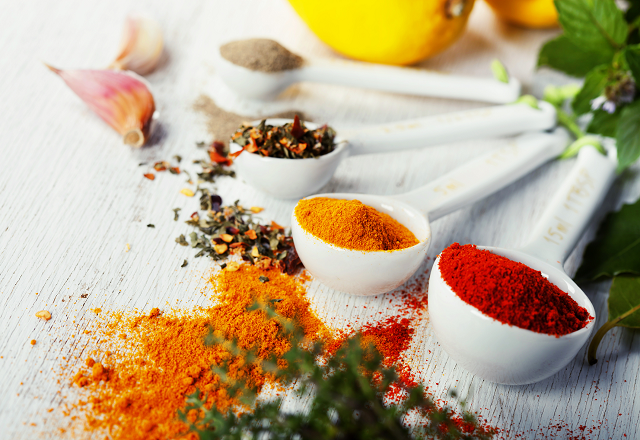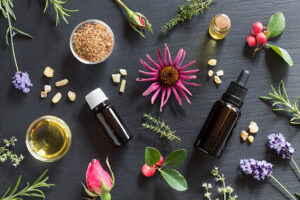Herbs not only add flavor, aroma and color to food but they can also provide many health benefits, such as anti-inflammatory properties and phytochemicals.
One 2022 study demonstrated how inhaling eucalyptus oil reduced pain and improved quality of life for those suffering from rheumatoid arthritis; however, high-quality studies on herbal supplements are limited.
1. Garlic
Hippocrates, known as “the father of medicine”, advocated the use of garlic for cleansing purposes such as lung congestion and abdominal growths. Garlic contains several vital nutrients and phytochemicals which have numerous health benefits.
Garlic has long been recognized for its antibacterial, antifungal and antiviral properties. Furthermore, it can lower cholesterol and blood pressure as well as improve circulation and lipid profiles.
when chopped or crushed, allicin is released from this herb, which has anti-inflammatory and antioxidant properties as well as being beneficial to diabetes, heart disease, cancer and other medical conditions.
There is some evidence that eating garlic may help protect against certain forms of cancer, but most of this comes from cohort studies which follow large groups over time. Herbal remedies may interact with medications and cause side effects.
2. Ginger
Ginger has long been used as both a dietary condiment and herbal remedy due to its anti-inflammatory, antinausea, and cancer fighting properties. Research on ginger’s bioactive components and metabolites is on the rise but additional work must be conducted on specific molecular targets and mechanisms of action.
Herbalists utilize entire plants or mixtures of plant parts rather than just one chemical in order to treat patients using herbal medicines, believing the body reacts favorably due to a delicate balance of chemicals present throughout each plant or mixture, rather than one single active ingredient being present alone.
Western and Chinese herbal medicine are both popular forms of herbal remedies. Traditional Chinese Medicine (TCM) seeks to restore balance to your “Qi”, or energy flow, by treating symptoms with herbs that complement each other – this practice is known as combination therapy and TCM can also be known by its alternative name: acupuncture.)
3. Red Clover
Red clover (Trifolium pratense) belongs to the legume family of plants that includes beans and peas. It’s widely recognized for its phytoestrogens – chemical compounds similar to estrogen – which have historically been used to alleviate symptoms associated with menopause such as hot flashes and night sweats, while also helping improve bone density and possibly helping lower cholesterol levels. Historically used to combat hot flashes during menopause; currently used to help relieve night sweats caused by menopause as well as reduce symptoms associated with menopause as symptom relief; historically used as treatment against hot flashes during menopause; may help improve bone density improvements as well as lower cholesterol levels significantly – see this page for more details!
Red clover’s isoflavones can help reduce inflammation in skin conditions like psoriasis and eczema, while stimulating collagen production to speed wound healing. Unfortunately, research has yet to verify if its uses prevent or treat other health problems – because its estrogen-like effects mean doctors do not advise it for women with history of breast cancer, nor those at risk of prostate or endometrial cancers.
4. Dandelion
No matter what side of the fence they come down on, dandelions have long been an integral part of springtime landscape. By adding them to salads or green smoothies, dandelions offer fiber, calcium, vitamins A-K-Iron benefits for an easy boost to nutrition.
Dandelion roots, leaves and flowers have long been utilized as laxatives and diuretics in traditional herbal medicine, serving to cleanse blood and boost its flow through diuresis. Test-tube studies indicate that compounds found in dandelion may help manage blood sugar levels among those with diabetes.
Dandelion leaves and roots contain bitter properties which help stimulate appetite, act as mild laxatives and increase bile flow to support liver and gallbladder health. You can enjoy drinking dandelion leaf tea for an enjoyable daily dose; or for therapeutic doses try liquid tinctures. To learn more about herbal natural remedies take CNM’s Herbs for Everyday Living short course.
5. Milk Thistle
Milk thistle (Silybum marianum) has long been promoted as a nutritional supplement to treat liver and gallbladder disorders. Its active ingredient, silymarin, contains antioxidant and antiviral properties; studies have demonstrated its efficacy at improving liver function while alleviating symptoms associated with cirrhosis such as fatigue and jaundice. Furthermore, its anti-inflammatory and lipid-reducing effects were demonstrated in one such study; one particular one also revealed how milk thistle helped decrease viral loads caused by hepatitis C that were unresponsive to interferon/ribavirin treatment!
Further research needs to be completed on milk thistle to ascertain its benefits and safety. As milk thistle may interact with certain cancer drugs or lower blood sugar, it’s wise to consult your physician prior to taking it if you have diabetes. It may also cause allergic reactions; pregnant or breastfeeding women should avoid it entirely.
6. Chamomile
Chamomile has relaxing, antispasmodic, and analgesic properties that may help improve digestion by soothing stomach pain, colic symptoms, or relieving IBS symptoms. Furthermore, Chamomile contains abundant antioxidants which combat free radicals – unstable molecules which contribute to chronic disease and accelerate aging – providing additional health benefits and fighting free radicals that accelerate aging processes.
Chamomile plants produce fragrant flowers which produce essential oil with soothing, anti-inflammatory, and antiseptic qualities, making it suitable for most adults; however, asthmatics should refrain from taking it. Furthermore, pregnant or breastfeeding women should refrain from chamomile consumption, as chamomile acts like estrogen and can potentially cause miscarriage.
There are two varieties of chamomile: German (Matricaria recutita), which is most frequently found in tea, and Roman, or English, Chamaemelum nobile – commonly grown from seeds but available as starter plants at garden centers as well. Both varieties may be purchased as starter plants as well.
7. Peppermint
Peppermint (Mentha x piperita) leaves and oil are widely used as medicine to ease symptoms related to digestion. Peppermint can also relieve headaches, irritated skin conditions, anxiety and depression as well as reduce spasms of the intestine and stomach while soothing pruritus (itching). In addition, it might prevent nausea during chemotherapy treatment as well as treating peptic ulcers and other gastrointestinal ailments.
Eucalyptus (Eucalyptus globulus) oil may help relieve pain and swelling, making it potentially effective against rheumatoid arthritis, fever and inflammation. It could even be used as a method for weight management.
Before trying any herbal remedies, individuals should consult with a health care provider. Some can interact with other medicines or cause side effects; people who have known allergies to certain plants should avoid them and test a small amount of essential oil on the skin to see if there is an allergic reaction.




